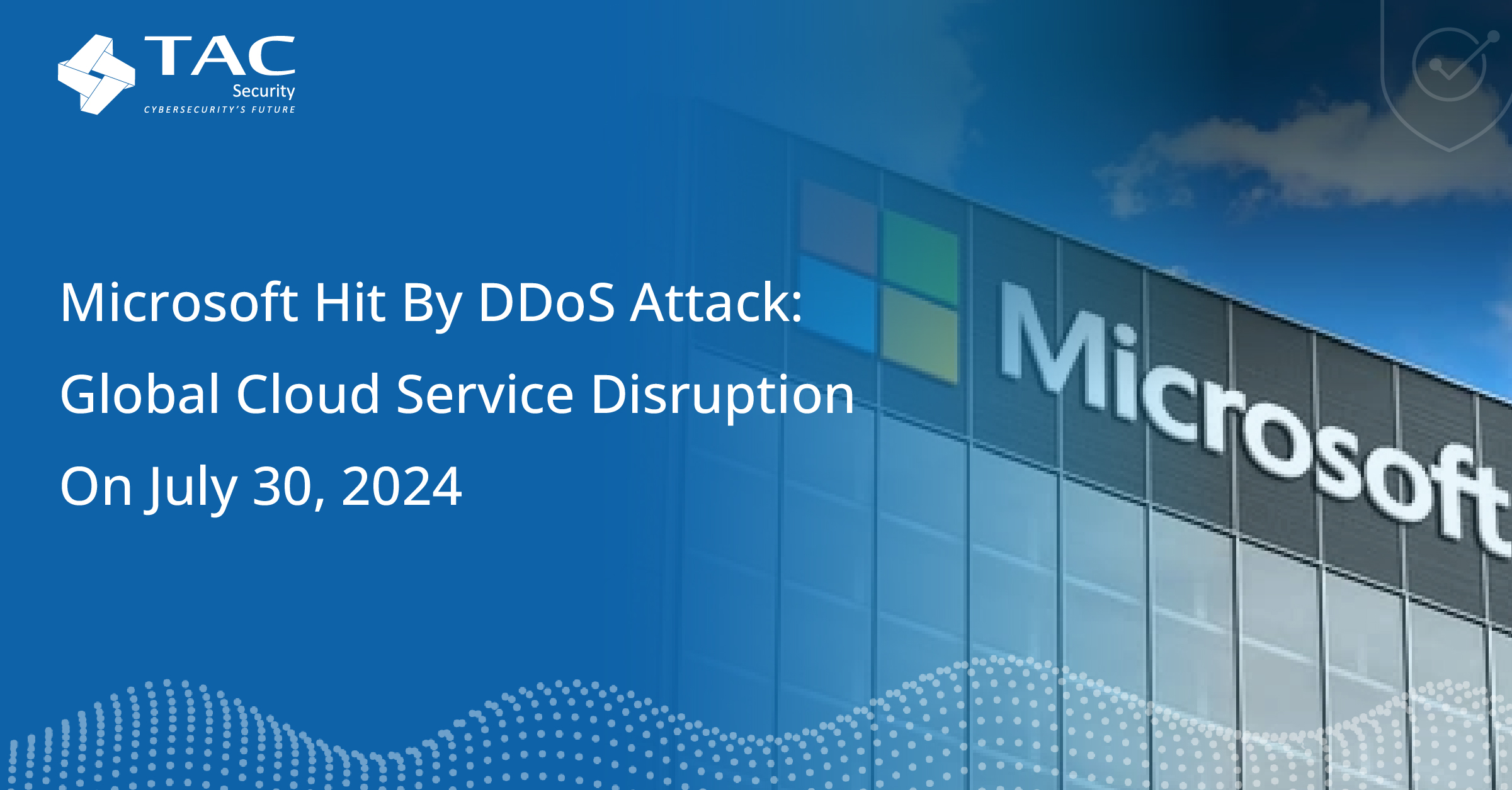Microsoft Hit by DDoS Attack: Global Cloud Service Disruption on July 30, 2024

On July 30, 2024, Microsoft experienced a significant disruption across its cloud services due to a Distributed Denial-of-Service (DDoS) attack. This incident, which lasted from 11:45 UTC to 19:43 UTC, impacted a range of services including Azure App Services, Application Insights, and the Azure portal, among others, causing widespread connectivity issues for customers globally.
The Attack and Immediate Response
Microsoft confirmed that the initial trigger was a DDoS attack, wherein adversaries flood services with excessive traffic to bring them to a standstill. The attack primarily targeted Azure Front Door (AFD) and Azure Content Delivery Network (CDN) components. Despite having DDoS protection mechanisms in place, an error in their implementation amplified the attack’s impact rather than mitigating it.
Upon recognizing the issue at 11:45 UTC, Microsoft’s team quickly implemented networking configuration changes and failovers to alternate paths. By 14:10 UTC, they had mitigated the majority of the impact. However, some customers continued to experience suboptimal service availability, prompting further actions around 18:00 UTC. A revised mitigation strategy was then rolled out, first in the Asia-Pacific and Europe, and subsequently in the Americas, normalizing failure rates by 19:43 UTC.
Investigation and Future Mitigation
Microsoft is conducting an ongoing investigation and has promised a preliminary post-incident review within 72 hours. The initial findings suggest that network configuration changes made to support DDoS mitigation led to unexpected side effects, exacerbating the issue.
The incident has highlighted the need for continuous innovation and investment in DDoS mitigation strategies. Dr. Richard Zhao, COO of International Business at NSFOCUS, emphasized the evolving threat landscape and the necessity for robust DDoS protection as a critical component of service reliability. He stated, “The recent Azure service outage due to a DDoS attack is a stark reminder of the evolving threat landscape. Given Azure’s position as a leading cloud service provider with substantial network resources and expertise, this incident underscores the increasing sophistication and scale of DDoS attacks.”
Global Impact and Customer Response
The outage affected several Microsoft services, including Azure IoT Central, Azure Log Search Alerts, Azure Policy, and subsets of Microsoft 365 and Microsoft Purview services. Notably, users in New Zealand continued to face issues accessing Microsoft 365 services, including Exchange Online, Outlook, and Microsoft Teams, even after the majority of services had returned to normal.
Companies such as U.K. bank NatWest were notably affected by the outage. The incident, lasting nearly 10 hours, came less than two weeks after a separate issue where a CrowdStrike update caused Microsoft Windows machines to crash.
Microsoft’s response to the incident involves a detailed internal retrospective to understand the incident better. The company aims to implement improved strategies and solutions to prevent such occurrences in the future. As Dr. Zhao pointed out, “It’s imperative for the industry to recognize that robust DDoS protection is not merely a defensive measure but a critical component of service reliability.”
This incident serves as a crucial reminder for all cloud service providers and their clients about the importance of advanced and continually evolving DDoS protection measures to ensure infrastructure resilience against increasingly sophisticated cyber threats.
The Role of Technology in Cybersecurity (ESOF Product) (How TAC Infosec will help in such situation)
In the context of a DDoS attack like the one that hit Microsoft, TAC Security’s Enterprise Security in One Framework (ESOF) product can offer several critical features and functionalities to help mitigate and prevent such incidents. Here’s how ESOF can be beneficial:
1. Proactive Threat Detection and Mitigation
ESOF is designed to provide real-time monitoring and analytics, which can help in the early detection of unusual traffic patterns that may indicate the onset of a DDoS attack. By identifying these threats early, ESOF enables organizations to take proactive measures to mitigate the impact.
2. Comprehensive Visibility
ESOF provides a unified dashboard that offers a comprehensive view of an organization’s security posture. This includes real-time insights into network traffic and potential vulnerabilities, helping security teams to quickly identify and respond to DDoS attacks.
3. Automated Response
ESOF can be configured to automatically respond to detected threats, such as by rerouting traffic, blocking malicious IP addresses, or activating additional defensive measures. This automated response capability is crucial during a DDoS attack, where the speed of response can significantly affect the outcome.
4. Integrated DDoS Protection
ESOF integrates advanced DDoS protection mechanisms that can absorb and deflect malicious traffic. This includes the ability to scale resources dynamically to handle the increased load and to use machine learning algorithms to differentiate between legitimate and malicious traffic.
5. Post-Incident Analysis
After an attack, ESOF provides detailed incident reports and analytics, helping organizations understand the nature of the attack, how it was executed, and what vulnerabilities were exploited. This information is crucial for strengthening defenses and preventing future attacks.
6. Collaboration and Coordination
ESOF facilitates better collaboration and coordination among security teams by providing a centralized platform for managing security incidents. This is especially important in large organizations with distributed teams that need to work together during a security incident.
7. Continuous Improvement
Through continuous monitoring and feedback, ESOF helps organizations improve their security posture over time. It provides actionable insights and recommendations for enhancing security policies, updating configurations, and patching vulnerabilities.
Specific Benefits During a DDoS Attack:
– Early Warning System: ESOF’s threat intelligence capabilities can provide early warnings about potential DDoS threats, allowing for pre-emptive action.
– Load Balancing and Traffic Management: ESOF can help manage traffic loads during an attack, ensuring that legitimate traffic can still reach critical services.
– Incident Response Planning: ESOF assists in developing and executing an incident response plan, ensuring that all teams know their roles and responsibilities during a DDoS attack.
By leveraging ESOF, organizations can enhance their resilience against DDoS attacks and ensure continuous availability and reliability of their services. This holistic approach to security helps in mitigating the impact of such attacks and maintaining customer trust.
Conclusion
The DDoS attack on Microsoft Azure highlights the ongoing threat of cyber-attacks against cloud service providers. Continuous investment in cybersecurity measures, incident response planning, and industry collaboration is essential to mitigate such risks and ensure service reliability.





